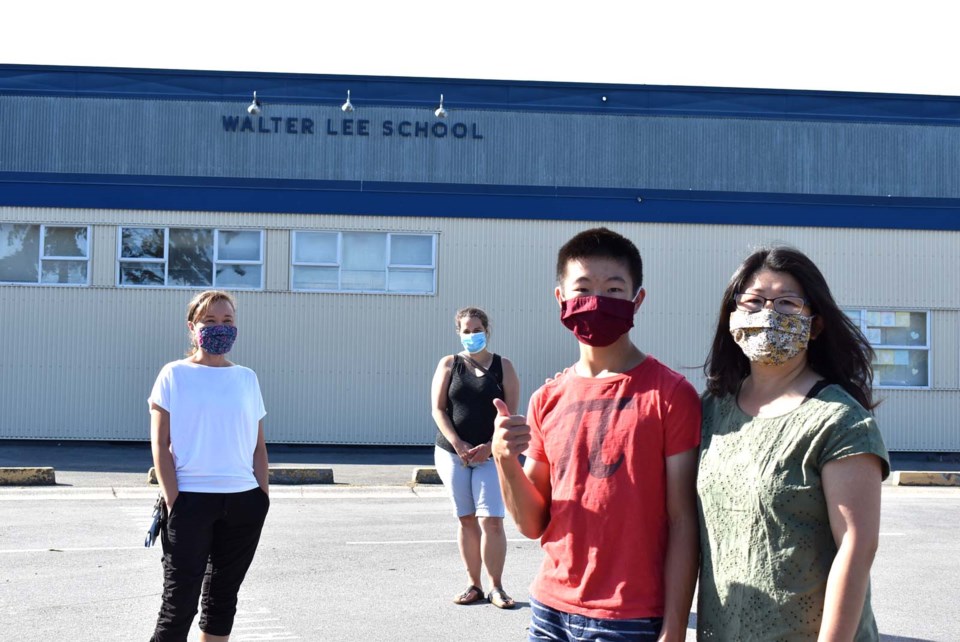Parents are calling on the Richmond School District and Ministry of Education to have remote learning options for families, masks in schools and assurance it will be safe to take their children to school on Sept. 10.
B.C. schools will enter “Stage 4” of learning in September, an in-class stage whereby students will be limited to learning groups depending on their age but will be expected to be back in the classroom full-time.
Parents are scrambling to figure out how to keep their kids safe but also make sure they are educated, said Richmond parent Cindy Cheung, adding she doesn’t understand why the Ministry of Education isn’t offering an alternative to in-class learning.
Cheung said her children were starting to get used to working with their teachers remotely in the spring and she’d like to see that option available through the fall instead of sending all students back en masse.
“What we had after spring break was starting to work — we were getting used it,” she said.
But the options being offered to parents are limited, said Cheung, whose children attend Walter Lee elementary — either put kids back in school or find an alternative solution, for example, online courses or home-schooling.
“It seems like there’s just their way or the highway — either go to school in that environment we completely don’t feel safe in or you go find your own thing and you pay for it,” Cheung said.
Emi Dyck, who has two children at Diefenbaker elementary, thinks there might be a “silent protest” on Sept. 10 with parents not sending their kids back.
The limited choices for education puts students between a rock and a hard place, Dyck said.
“Our kids are being held hostage,” she added.
Distance learning in Richmond includes individual courses from Grades 10 to 12, the Richmond Academy of Learning (RAIL) for Grades 8 to 10 and the Sky program for Grades 11 and 12. The only other option offered is homeschooling, something Dyck doesn’t feel she’s qualified to do.
Dyck said she’s “on the fence” about sending her children back to school in September, and many of her friends are in the same boat, scared to send their kids back during a global pandemic.
Emails she has sent to the Ministry of Education elicit the “same generic reply” every time.
“Parents are the biggest stakeholders and yet we have the smallest voice,” Dyck said.
Even if children get milder symptoms of COVID-19, there is still the possibility they can bring it home to their parents and grandparents, Dyck said, a sentiment echoed by Cheung.
“Why are we taking these risks? We’re in the middle of a pandemic,” Dyck said.
For Cheung, the back-to-school plan seems go against health orders — with cohorts of 60 and 120 students and no mandatory masks except in places like hallways and buses.
Cheung believes B.C. was able to keep its COVID-19 numbers low partially because schools were shut down to in-class instruction for the most part.
If there aren’t online options for learning, Cheung said there are many “realistic options” that schools can implement, for example, smaller classes, plastic partitions, mandatory masks, but these are not ideas being floated by educators.
Other countries who sent kids back to school have implemented things like masks and partitions — it’s not “rocket science,” she said.
A letter was sent to parents on July 31 acknowledging there may be anxiety about returning to school but appealing for “patience as we continue to navigate the latest direction from the provincial government.”
Richmond School District spokesperson David Sadler said district staff is meeting this week with stakeholder groups after receiving a template on Aug. 11 on how schools will function.
They are following timelines set out by the ministry to develop district-specific plans.
The feedback from stakeholders, including the Richmond District Parent Association and the Richmond Teachers’ Association, will help to develop the plan. Their plan has to be submitted to the ministry by Aug. 21 for approval and will be made public on Aug. 26.
“The (school) district can’t rush any of those timelines,” Sadler said.
But Vivian Jinn, whose children are at Walter Lee elementary, said the start date is approaching fast and parents have been given very few details on what school will look like.
She is worried about students going back on Sept. 10, giving teachers, principals and other staff just two days to learn how the new normal will work.
“I don’t know how much can be accomplished in two days,” she said.
If parents were given some ideas on how to prepare — rules that will be in place, for example — they could start running them through with their children in anticipation of going back, Jinn said.
But the unknown situation is what is causing her anxiety as the school start date approaches.
The superintendent of the Richmond School District, Scott Robinson, declined requests for an interview with the Richmond News.
Learning groups
Elementary: 60 students
Secondary: 120 students
Examples: single class; multiple classes that meet for learning activities; group of high school students with the same courses
Benefits: Allows in-class instead of remote learning; increases interaction, avoids isolation; peer support and connection; decreases impact on mental health
Source: K-12 Education Restart Plan
Five-stage framework for K-12
Stage 1: No cohort limit, full-time, in-class instruction
Stage 2: 60-student elementary cohorts; 120-student secondary cohorts; full-time, in-class instruction
Stage 3: 30-student elementary cohorts; 60-student secondary cohorts; 50-per-cent density; full-time for children of essential workers, children with disabilities or who need extra support; self-directed and remote learning as supplements
Stage 4: 30-student elementary cohorts; 60-student secondary cohorts; 25-per-cent density; full-time for children of essential workers, children with disabilities or who need extra support; self-directed and remote learning as supplements
Stage 5: No cohorts; zero per cent density; all in-class instruction suspended; self-directed and remote learning
Source: K-12 Education Restart Plan



